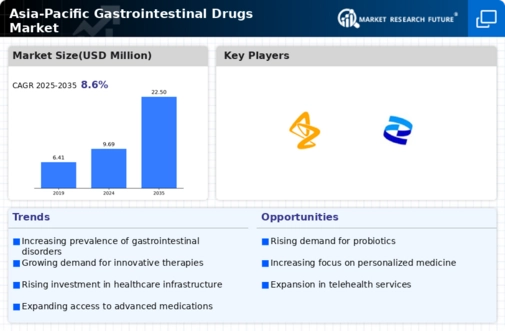Asia Pacific Gastrointestinal Drugs Market Summary
The Asia-Pacific Gastrointestinal Drugs market is projected to experience substantial growth from 9.69 USD Billion in 2024 to 22.5 USD Billion by 2035.
Key Market Trends & Highlights
Asia-Pacific Gastrointestinal Drugs Key Trends and Highlights
- The market is expected to grow at a compound annual growth rate (CAGR) of 7.94% from 2025 to 2035.
- By 2035, the market valuation is anticipated to reach 22.5 USD Billion, indicating robust demand for gastrointestinal therapies.
- In 2024, the market is valued at 9.69 USD Billion, reflecting a solid foundation for future expansion.
- Growing adoption of advanced therapeutic options due to increasing prevalence of gastrointestinal disorders is a major market driver.
Market Size & Forecast
| 2024 Market Size | 9.69 (USD Million) |
| 2035 Market Size | 22.5 (USD Million) |
| CAGR (2025-2035) | 7.94% |
Major Players
Abbott, Allergan Plc, AstraZeneca, Eli Lilly Company, F. Hoffmann-La Roche Ltd, GlaxoSmithKline plc, Pfizer Inc, Valeant Pharmaceuticals













Leave a Comment